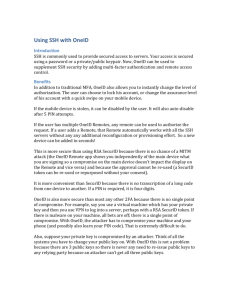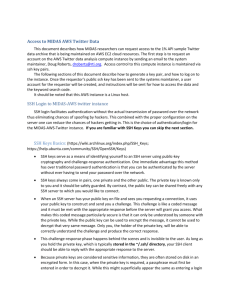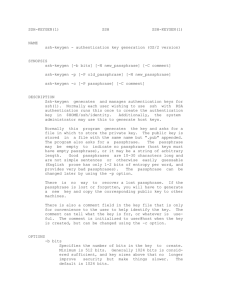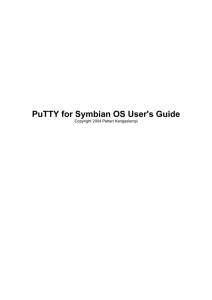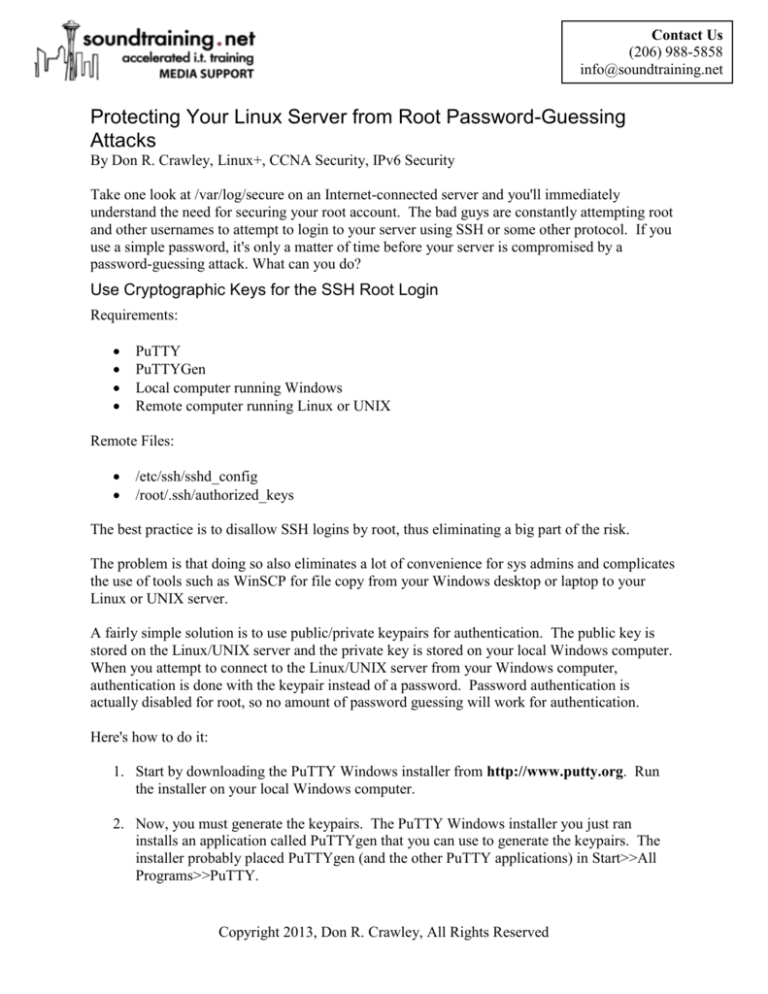
Contact Us
(206) 988-5858
info@soundtraining.net
Protecting Your Linux Server from Root Password-Guessing
Attacks
By Don R. Crawley, Linux+, CCNA Security, IPv6 Security
Take one look at /var/log/secure on an Internet-connected server and you'll immediately
understand the need for securing your root account. The bad guys are constantly attempting root
and other usernames to attempt to login to your server using SSH or some other protocol. If you
use a simple password, it's only a matter of time before your server is compromised by a
password-guessing attack. What can you do?
Use Cryptographic Keys for the SSH Root Login
Requirements:
PuTTY
PuTTYGen
Local computer running Windows
Remote computer running Linux or UNIX
Remote Files:
/etc/ssh/sshd_config
/root/.ssh/authorized_keys
The best practice is to disallow SSH logins by root, thus eliminating a big part of the risk.
The problem is that doing so also eliminates a lot of convenience for sys admins and complicates
the use of tools such as WinSCP for file copy from your Windows desktop or laptop to your
Linux or UNIX server.
A fairly simple solution is to use public/private keypairs for authentication. The public key is
stored on the Linux/UNIX server and the private key is stored on your local Windows computer.
When you attempt to connect to the Linux/UNIX server from your Windows computer,
authentication is done with the keypair instead of a password. Password authentication is
actually disabled for root, so no amount of password guessing will work for authentication.
Here's how to do it:
1. Start by downloading the PuTTY Windows installer from http://www.putty.org. Run
the installer on your local Windows computer.
2. Now, you must generate the keypairs. The PuTTY Windows installer you just ran
installs an application called PuTTYgen that you can use to generate the keypairs. The
installer probably placed PuTTYgen (and the other PuTTY applications) in Start>>All
Programs>>PuTTY.
Copyright 2013, Don R. Crawley, All Rights Reserved
Contact Us
(206) 988-5858
info@soundtraining.net
3. When you run PuTTYgen for the first time, you must generate a new keypair. At the
bottom of the PuTTYgen window are three parameters choices including SSH-1 (RSA),
SSH-2 RSA, and SSH-2 DSA. SSH-2 RSA is the default choice with a default key
length of 1024 bits. Longer key lengths are more secure, but require more processing
power. 1024 bits is an acceptable compromise at this time (late 2010), but may not be
acceptable in the future as computer processing power continues to increase.
Copyright 2013, Don R. Crawley, All Rights Reserved
Contact Us
(206) 988-5858
info@soundtraining.net
4. Click the button labeled Generate to produce your public and private keys. (You must
move your mouse pointer over the blank area at the top of the screen to generate some
randomness for use in producing the keypair. Just move your mouse pointer in a cirular
motion over the blank area until the progress bar reaches the far right side and PuTTYgen
generates the keys.)
5. You can now save the private key on your local laptop or desktop computer and copy the
public key to the remote Linux/UNIX server.
6. Enter and confirm a passphrase to protect the private key in the two fields in PuTTYgen.
7. Click the button labeled Save private key and select a location on your local hard drive to
save the private key. (Remember to protect your private key by storing it securely!) I
also like to save my public key as a text file to simplify using it in the future.
8. Copy the jibberish text that is the public key (at the top of the PuTTYgen window) and
paste it into /root/.ssh/authorized_keys on your server (You might have to create the .ssh
directory and you'll probably have to create the authorized_keys file. Note also that the
.ssh directory is a hidden directory whose name starts with a period.). If you saved your
public key as a text file in the previous step, you can simply copy the contents of that file
to /root/.ssh/authorized_keys.
Copyright 2013, Don R. Crawley, All Rights Reserved
Contact Us
(206) 988-5858
info@soundtraining.net
9. On your Linux/UNIX server, inspect /etc/ssh/sshd_config to ensure that RSA
authentication and public key authentication are both allowed by modifying three lines in
the sshd_config. Depending on your system, you will have to change "no" to "yes" or
uncomment the lines to allow the authentication. Also, ensure that the path to the
authorized_keys file is set to "%h/.ssh/authorized_keys" and uncomment the line. (I
found the three lines at approximately line 43 on a RedHat system and approximately line
29 on a Debian system.) When you're done, the lines should look like this:
RSAAuthentication yes
PubkeyAuthentication yes
AuthorizedKeysFile %h/.ssh/authorized_keys
10. In order for the changes to be read into RAM, you must restart SSHD:
11. If you attempt to log on now with the username root and the root password, the logon
attempt will be denied:
12. You must now configure PuTTY to use the public/private key pair for authentication.
Open PuTTY, in the left-hand menu area expand SSH and select Auth. On the right-hand
side of the window, browse to the location where you stored your private key or simply
enter it in the field below “Private key file for authentication:”.
Copyright 2013, Don R. Crawley, All Rights Reserved
Contact Us
(206) 988-5858
info@soundtraining.net
Again, in the left-hand menu, select Session (at the top of the list). On the right-hand side
of the screen, enter the IP address or hostname of your Linux server and click the button
labeled “Open”.
13. When PuTTY connects to the server, enter “root” for the username. You will be
prompted for the passphrase you configured for your private key. Enter the correct
passphrase and you should be logged on to your server as root.
The benefit of performing the preceding steps is that it is nearly impossible for an attacker to log
on to your server as root by guessing the password. In order for the attacker to masquerade as
root, she or he would have to have your private key and know the passphrase associated with it.
Copyright 2013, Don R. Crawley, All Rights Reserved
Contact Us
(206) 988-5858
info@soundtraining.net
The Accidental Administrator: Linux Server: Step-ByStep Configuration Guide
By Don R. Crawley
188 pages
CreateSpace (October 27, 2010)
ISBN-10: 1453689923 ISBN-13: 978-1453689929
About the author
Don R. Crawley author of The Accidental Administrator: Linux Server
Step-by-Step Configuration Guide and President of soundtraining.net a
Seattle, Washington-based IT training firm. He is a veteran IT guy with
over 35 years experience in technology for the workplace. He holds
multiple certifications on Microsoft, Cisco, and Linux products. Don
can be reached at (206) 988-5858 www.soundtraining.net
don@soundtraining.net
You have permission to reprint this article in your newsletter, blog, website, or publication if you
include the following paragraph (Is it too long? No problem. Just contact us for an edit.):
Don R. Crawley is a longtime geek and President/Chief Technologist of soundtraining.net with more than
35 years in workplace technology. He holds multiple technical certifications and is the author of
numerous books on information systems and technology, including The Accidental Administrator: Linux
Server Step-by-Step Configuration Guide. He has spoken to audiences worldwide on both technical
topics and IT customer service. To view this Seattle IT pro's upcoming events or to receive free Cisco
tutorials, Linux tutorials, IT customer service tips, and other guides that will help you with Cisco training,
Linux training, customer service training, and other skills you need to know to build a great career in IT,
visit www.soundtraining.net or contact us at don@soundtraining.net or 206-988-5858.
Copyright 2013, Don R. Crawley, All Rights Reserved




